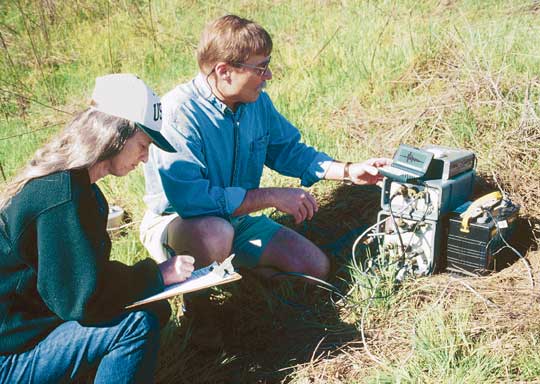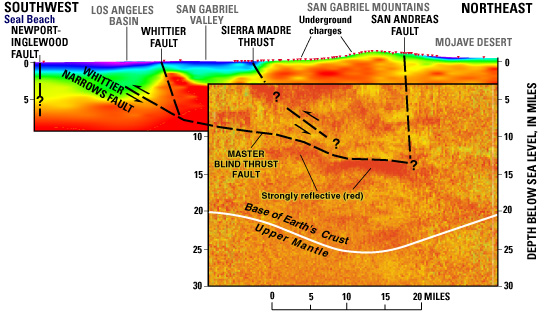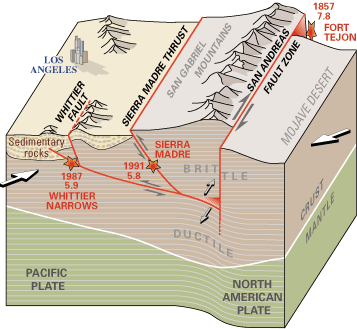
USGS Fact Sheet 110–99
Online Version 1.0

USGS Fact Sheet 110–99
Online Version 1.0
![]()

| The Los Angeles region is underlain by a network of active faults, including many that are deep and do not break the Earth's surface. These hidden faults include the previously unknown one responsible for the devastating January 1994 Northridge earthquake, the costliest quake in U.S. history. So that structures can be built or strengthened to withstand the quakes that are certain in the future, the Los Angeles Region Seismic Experiment (LARSE) is locating hidden earthquake hazards beneath the region to help scientists determine where the strongest shaking will occur. |
On January 17, 1994, the costliest earthquake in the history of the United States struck the Los Angeles region, killing 57 people, leaving 20,000 homeless, and causing more than $20 billion in damage to homes, public buildings, freeways, and bridges. This magnitude 6.7 quake occurred 10 miles beneath the town of Northridge on a previously unknown ramp-like ("thrust") fault not visible at the Earth's surface. Many faults, including such hidden or "blind" faults, in the Los Angeles region are capable of producing even stronger earthquakes.
 |
||

|
Home to millions of people, the Los Angeles region is underlain by numerous active faults, many of which cannot be seen at the Earth's surface. One of these hidden faults produced the January 17, 1994, Northridge earthquake, which caused 57 deaths and widespread damage—photo at right shows vehicles stranded by the collapse of sections of Interstate Highway 5. (Top photo courtesy of Arnesen Photography/LACVB, PictureLA.com; by and copyright Erik Arnesen. Photo at right by Brant Ward; copyright San Francisco Chronicle.)
|
|
In the aftermath of the Northridge earthquake, residents of the Los Angeles region are asking whether a strong quake can strike near their home and, if so, how hard the ground will shake. Scientists are working to answer these questions so that damage can be reduced in the next big earthquake and future quakes. A crucial step is getting an accurate picture of the network of active faults that underlie the Los Angeles region.
In 1993, scientists from the Southern California Earthquake Center (SCEC), the U.S. Geological Survey (USGS), and other organizations began the Los Angeles Region Seismic Experiment (LARSE) to collect seismic images, or pictures, of the Earth's crust beneath the region. The goals of LARSE are to obtain images of faults at depth, especially of blind thrust faults, and also to obtain data on the subsurface shapes of sedimentary basins (large valleys filled with sedimentary deposits). Knowing the configuration of buried faults is crucial to understanding how the earthquake-producing "machinery" works in the Los Angeles region, and information on the thickness and shape of the region's sedimentary basins is essential for predicting how hard the ground will shake in future quakes.
 |
 |
|
| The U.S. Geological Survey (USGS) scientists shown here are using one of the seismographs that record underground sound waves in the Los Angeles Region Seismic Experiment (LARSE). These recordings are analyzed by powerful computers to produce images of the subsurface of the L.A. region. To generate sound waves, LARSE in part uses small charges set off at the bottoms of holes drilled to more than 60 feet below the ground surface (see photo to right of mobile drill rig). |
LARSE uses sound waves traveling beneath the Earth's surface to produce seismic images. These sound waves are generated by underwater bursts of compressed air in the offshore region and by small underground explosions on land. The sound waves from airgun bursts and buried explosions are received by hundreds of portable recording instruments (seismographs). The recorded data are then analyzed by powerful computers to produce images of the subsurface. LARSE also makes use of seismic waves from natural earthquakes. Because the project's explosive charges are small and are set off at the bottoms of holes drilled to more than 60 feet below the ground surface, they do not cause property damage, and there is no chance of their triggering an earthquake. By 1998, the LARSE project had made several important discoveries. Images of the sedimentary basin beneath the San Gabriel Valley show that its depth reaches 3 miles, 50% more than earlier estimates. Because deeper sedimentary basins have greater shaking potential, earthquake hazards in the San Gabriel Valley need to be reevaluated.
 |
The LARSE project is completing the onshore part of the second of two major lines of data collection across the Los Angeles region. LARSE uses hundreds of portable seismographs to record underground sound waves, which are analyzed to create subsurface images of the Earth's crust. In 1994, these sound waves were generated by underwater bursts of compressed air in the offshore region on both Lines 1 and 2 and by small, buried explosive charges on land on Line 1. To complete Line 2, drilling of holes for underground charges starts in the summer of 1999, and actual data collection begins in October. Data collected in 1994 along Line 1 were used to produce the image and diagram at right. Red stars with numbers (magnitudes) are earthquakes of magnitude 5.8 and greater since 1932.Yellow squares along Lines 1 and 2 denote 1994 airgun bursts. Red dots along Line 1 denote 1994 underground charges. Recently active faults are shown in red. |
Another major finding is a strongly reflective zone located deep beneath the San Gabriel Mountains. This zone begins at about 12 miles depth near the vertical San Andreas Fault and rises in a ramp-like fashion southward toward the Los Angeles Basin. It appears to connect to the fault system responsible for the 1987 magnitude 5.9 Whittier Narrows earthquake, which occurred on a blind thrust fault. This reflective zone is interpreted as a "master" blind thrust fault that transfers stress and strain upward and southward to a network of faults in the San Gabriel Valley and Los Angeles Basin.
The LARSE data obtained so far have provided answers that could not have been obtained in any other way. The LARSE project is completing the onshore part of the second of two major lines of data collection across the Los Angeles region. This 60-mile line (Line 2) extends from the coast to the Mojave Desert. Drilling of holes for the placing of underground charges starts in the summer of 1999, and actual data collection begins in October.

|
The LARSE project uses powerful computers to analyze transmitted and reflected underground sound waves to produce images of the Earth's crust, similar to the way in which medical CAT-scan images (transmitted X-rays) and ultrasound images (reflected sound waves) are created. Transmitted sound waves pass through the area being imaged, revealing the geologic structure by the ways they are bent or slowed. Reflected sound waves bounce off faults and rock layers, showing the shapes and depths of those features. Data collected along Line 1 of LARSE were used to create this composite image of the geologic structure beneath the Los Angeles region. Color bands in the upper part of the image, derived from computer analysis of transmitted sound waves, show the speed at which waves pass through different rock types—slower speeds (cooler colors) are in less dense rock. The deeper rectangular part of the image shows results from reflected sound waves—strongly reflective areas are in bright red. The intensely reflective zone deep beneath the San Gabriel Mountains is interpreted by LARSE scientists as a "master" blind thrust fault—a thrust fault that transfers stress and strain from near the San Andreas Fault to the network of faults in the San Gabriel Valley and Los Angeles Basin. |
 |
This diagram, based on the subsurface image made along Line 1 of the LARSE project (see above), shows an interpretation of the geologic structure beneath part of the Los Angeles region. Many faults in the region are capable of producing powerful earthquakes. Vertical faults, such as the San Andreas Fault, commonly are clearly visible at the Earth's surface. However, ramp-like faults, or "thrust" faults, such as the one responsible for the 1987 Whitter Narrows earthquake, often do not break the surface; these hidden faults are targeted by the LARSE project. In this diagram, relative movement on faults is shown by pairs of small arrows. Large white arrows show the oblique direction in which the Pacific Plate (left) and the North American Plate (right) are converging. Red stars with dates and numbers (magnitudes) are earthquakes. |
The cooperative efforts of SCEC, USGS, and other scientists in the LARSE project are helping to find hidden faults and areas of potential strong earthquake shaking in the Los Angeles region. This knowledge is essential to making new and existing structures in the region better able to withstand earthquakes. The work of SCEC and USGS scientists in LARSE is only part of the National Earthquake Hazards Reduction Program's ongoing efforts to protect people's lives and property from the earthquakes that are inevitable in southern California and elsewhere in the United States.
By
Thomas L. Henyey, Gary S. Fuis, Mark L. Benthien, Thomas R. Burdette, Shari A. Christofferson, Robert W. Clayton, Edward E. Criley, Paul M. Davis, James W. Hendley II, Monica D. Kohler, William J. Lutter, John K. McRaney, Janice M. Murphy, David A. Okaya, Trond Ryberg, Gerald W. Simila, and Peter H. Stauffer
Graphics by Sara Boore, Susan Mayfield, Stephen Scott, and Michael Diggles
Web design by Carolyn Donlin
COOPERATING ORGANIZATIONS
California Department of Parks and Recreation
California Department of Transportation
California Division of Mines and Geology
California Office of Emergency Services
California State University, Northridge
Canadian Geological Survey
City of Los Angeles
County of Los Angeles
Copenhagen University, Denmark
GeoForschungsZentrum, Potsdam, Germany
Incorporated Research Institutes for Seismology
Karlsruhe University, Germany
Lamont-Doherty Earth Observatory
Los Angeles Unified School District
Metropolitan Water District of Southern California
Santa Monica Mountains Conservancy
Southern California Earthquake Center
University of Texas at El Paso
U.S. Army Corps of Engineers
U.S. Bureau of Land Management
U.S. Department of Agriculture, U.S. Forest Service
U.S. Naval Weapons Station, Seal Beach
Many private and government landowners
For more information contact:
Southern California Earthquake Center
University of Southern California, Mail Code 0742
Los Angeles, CA 90089–0742
Telephone: (213) 740–0323
Visit the Southern California Earthquake Center or the USGS Earthquake Hazards site on the Web
See also
Southern Californians Cope with Earthquakes (USGS Fact Sheet 225-95)
Speeding Earthquake Disaster Relief (USGS Fact Sheet 097-95)
Download a PDF version of this fact sheet
Disponible también en Español: USGS Fact Sheet 111–99 (ese documento es PDF)